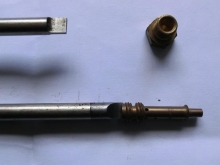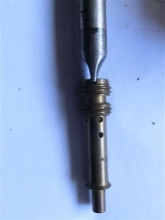slow running tube zenith 13 tca2 question
What's the best method of extracting a stuck slow running tube from a zenith 13 tca 2 without damaging it?
I have heated the body with an electric paint stripping gun and applied plus-gas and attempted pulling with pliers but being brass a I dare not apply to much pressure in case I squash it.
I did remove one successfully before, but I used a blow torch and succeeded in melting the body a little bit. The carb worked though, although being very worn mechanically it did not idle very well.
I don't want to risk doing that again.
Forums
Thanks
Thanks
It's out - intact. I inserted a welding cleaning tip which fitted the tube exactly preventing it from collapsing when extracting. I used a bit of a slight twisting motion to free it.
The needle seat was also a pig to get out, somebody had been riving on with that and damaged the slot.
That's a great idea and like
That's a great idea and like many such ideas - so simple!
On the subject of your needle seat , brass carburettor jets and emulsion tubes with a single screwdriver slot are prone to suffering from similar abuse but the best approach is a decent hollow ground screwdriver which, unlike a conventional slightly tapered one, will reduce the tendency to cam out of the slot.


Equally, if the seat or jet has a hexagon rather than a slot the best approach is with a single hex socket rather than the more usual bi-hex or multi hex socket.
thanks for sharing the photos
thanks for sharing the photos.
I will have a look for one of those, although in my case the damage was already done by somebody else.
I had to resort to heat mole-grips and plus gas as it was well and truly jammed with varnish
Jet screw drivers.
Jet screw drivers.
Originally I made my own from a bit of silver steel rod but over the years collected a couple of others.
The green one is a German made Weralit which was, I think, an Aspera " special tool" and the two red ones are of American Millers Falls manufacture bought as Briggs and Stratton service tools.


They can be difficult but I
They can be difficult but I would say that you are on the right track with the hot air gun although before I owned such a thing I found that putting the whole carb bowl in a pan of water on the stove and giving it a good rolling boil for about five minutes got a good uniform heat into it.
The calibrated bit is at the opposite end so you can afford to be a bit brutal with the bit that's sticking up. Good square ended pliers end on and wiggle a bit or failing that and with care, side cutters as close to the bowl body as poss but with a small diameter nail or twist drill laid across the top as a fulcrum and then lever down on the handles .
If you do squash it a bit they can be recovered with the careful application of the tip if a scriber to restore the shape and replacements are still available.
The fuel for the slow running mix is drawn up that tube (more correctly pushed up by atmospheric pressure) into a gallery below the idle adjustment screw from where, when mixed with air, it enters the inlet manifold through a tiny hole (no 6 on the second Dropbox link) which is only visible / accessible looking into the manifold from the engine end - and then with a good light. On a couple of occasions I have found that hole blocked and had to probe it with a bit of fine wire to clear it.
https://www.dropbox.com/s/7fq3j5ddzcxqo5l/Zenith%20carb0001.pdf?dl=0
https://www.dropbox.com/s/smgavyf7tw1a3si/Zenith%20carburettor0001.pdf?…